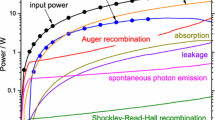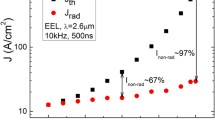Abstract
We have estimated the characteristic temperature T0 of GaN-based vertical-cavity surface-emitting lasers. The density matrix theory including intraband relaxation broadening has been taken into account. The estimated T0 is about 300 K, which suggests a good temperature characteristic in GaN-based lasers.
Similar content being viewed by others
Introduction
Gallium nitride (GaN) and related compounds have large bandgap energies and are attractive for light-emitting devices operating in blue to ultraviolet spectral regions [1,2]. Recently, room temperature pulsed operation of GaN-based laser diodes (LDs) has been reported [3]. In these reports, it was shown that the introduction of a quantum well (QW) structure as an active layer is very effective for realizing the GaN-based laser. The characteristic temperature of lasers is one of the important parameters for applications such as to optical memories, from the viewpoint of high-temperature operation. A less sensitive temperature is preferable for wide-ranging applications. In this paper, we report the estimation of temperature sensitivity for a GaN-based laser with a quantum well structure as the active layer.
The internal quantum efficiency of GaN QW layers is one of the important issues in terms of low power consumption and operation reliability. In the first step, carrier confinement in a GaN QW layer is estimated.
Carrier Confinement Ratio
We have assumed the equilibrium condition in a single QW structure and defined the confinement ratio as a function of the density of states, as shown in the following equation.
Where, Rconf, N2D and N3D are the confinement ratio, number of carrier in a QW layer and barrier layers, respectively. In this estimation, we have assumed a quantum well with a finite offset. The density of states in the single QW layer (2-dimensional), g2D(E) and the barrier layer (3-dimensional), g3D(E) can respectively be written as [4]
The total carrier concentration, Ntot in the QW and barriers is expressed as
Where, f(E,Ef) is Fermi distribution function. From eqs. (1) - (4), we can derive the equation of the carrier confinement ratio.
The confinement ratio of the GaN/AlGaN QW structure as a function of the injected carrier density is shown in Fig. 1. We also show that of the GaAs/AlGaAs QW for comparison. We assumed that the band offset ratios of ΔEc/ΔEv are 0.71/0.29 [5,6] for GaN/AlGaN QWs and 0.65/0.35 [7] for GaAs/AlGaAs QWs. In the case of GaN-based VCSELs, an injected carrier density higher than 5 × 1018 cm−3 is roughly required for laser operation. A high confinement ratio is required at high carrier densities for laser device application. If we adopt an AlGaN layer with an aluminum composition higher than 10% as the barrier layer, the confinement ratio is almost unity, which means that all injected carriers are confined to the QW layer. In this case, we can regard the QW layer as an infinite potential well.
Optical Gain
The optical gain of GaN QW layers is an important parameter in the estimation of the threshold current density. The estimation of the linear gain for GaN QWs is carried out using the density-matrix theory with intraband relaxation broadening [8-10]. This model is already established for GaAs-based and InP-based semiconductor lasers, and the calculated results show good agreements with those of experiments. We assumed the square of the dipole moment, <Rch 2> to be a function of bandgap energy and GaN quantum wells to have an infinite potential barrier. The parameters used in this estimation are summarized in Table I. The linear gain is given by [9]
where
ω denotes the angular frequency, μ is the magnetic permeability, ε is the dielectric constant, n is the refractive index of the active layer. The Fermi-Dirac distribution in the conduction band fc(E) and valence band fv(E) are assumed, and τin is the intraband relaxation time. Ecn and εcn denote sub-band energy and total energy of electron in quantized level, respectively.
Characteristic Temperature
The maximum gain is plotted as a function of the injected carrier density in Fig. 2. At present, the intraband relaxation time of a GaN system has not yet been reported. Therefore, we assumed that the relaxation time τin is 0.1 ps, which is normally used in the case of estimation for GaAs-based laser [8]. In InGaN QWs Lasers, it is reported that τin is 0.05 ps [10]. Now, we assumed τin is independent on temperature, its affection for the temperature dependence of threshold current is negligible. We also assumed that the bandgap energy of GaN and the change of the optical cavity length have a negligible dependence on temperature, taking into consideration the small change of temperature near 300 K is considered. The blue/ultraviolet vertical-cavity surface-emitting lasers (VCSELs) are candidates for use in optical imaging systems such as high-density optical memories and photolithography because these lasers have advantages in the fabrication of two-dimensional array structures, as well as low power consumption [11]. The structure shown in Fig. 3 is considered for our estimation of the threshold current density. We did not consider a change of the optical cavity length to be a function of the temperature, which indicates that the threshold current density of GaN is higher than that of GaAs. However, the temperature sensitivity of a transparent carrier density on GaN QWs is almost the same as in the case of GaAs QWs. Although the required threshold current density is still high, the characteristic temperature T0 of GaN-based VCSELs is expected to be ∼ 300 K as shown in Fig. 4. It has been reported that the temperature sensitivities of stripe-type InGaN QW lasers are about 170 [12] and 320 K [13]. The ideal characteristic temperature of GaN QWs is comparable to that of GaAs QWs. The estimation shows that the GaN-based VCSEL has good operation reliability for application to systems.
It has been reported that the ideal characteristic temperature of GaAs QWs is about 330 K [14], which is compatible with our estimation using the same method as that for GaN QWs. On the other hand, the experimental characteristic temperature of GaAs is lower than the estimated one. The estimated high T0 in GaN LDs might be due to the suppress a carrier leakage over heterobarriers [14], or the automatic introduction of a low dimensional structure like as a localized state in an active layer [13].
Summary
In summary, we have estimated the threshold current density of GaN-based VCSELs using QW layers as an active layer and the characteristic temperature T0 of GaN-based lasers. However, a high-injected carrier density is required for the laser operation to achieve the estimated sensitivity of about 300 K, which suggests the possibility of a high-temperature operation of GaN-based VCSELs.
References
H. P. Maruska and J. J. Tietjen: Appl. Phys. Lett. 15, 327 (1969).
I. Akasaki, H. Amano, S. Sota, H. Sakai, T. Tanaka and M. Koike: Jpn. J. Appl. Phys. 34, L1517 (1995).
S. Nakamura, M. Senoh, S. Nagahama, N. Iwasa, T. Yamada, T. Matsushita, H. Kiyoku and Y. Sugimoto: Jpn. J. Appl. Phys. 35, L74 (1996).
M. W. Praire and R. M. Kolbas: Superlattice and Microstructures 7, 269 (1990).
S. H. Wei and A. Zunger: Appl. Phys, Lett. 69, 2719 (1996).
G. Martin, S. Strite, A. Botchkarev, A. Agarwal, A. Rockett, H. Morkoç, W. R. L. Lambrecht and B. Segall: Appl. Phys. Lett. 65, 610 (1994).
H. Kroemer: Surf. Sci. 174, 299 (1985).
M. Asada and Y. Suematsu: IEEE J. Quantum Electron. 21, 434 (1985).
M. Asada, A. Kameyama and Y. Suematsu: IEEE J. Quantum Electron. 20, 745 (1984).
S. Nakamura, M. Senoh, S. Nagahama, N. Iwasa, T. Yamada, T. Matsushita, Y. Sugimoto and H. Kiyoku: Appl. Phys. Lett. 69, 1568 (1996).
T. Honda, A. Katsube, T. Sakaguchi, F. Koyama and K. Iga: Jpn. J. Appl. Phys. 34, 3527 (1995).
S. Nakamura, M. Senoh, S. Nagahama, N. Iwasa, T. Yamada, T. Matsushita, Y. Sugimoto and H. Kiyoku: Jpn. J. Appl. Phys. 36, L1059 (1997).
S. Nakamura, M. Senoh, S. Nagahama, N. Iwasa, T. Yamada, T. Matsushita, H. Kiyoku and Y. Sugimoto: 43rd Spring Meet. Jpn. Soc. Appl. Phys. & Related Soc., 29aZB-14, Asaka (1996).
N. K. Dutta: J. Appl. Phys. 53, 7211 (1982).
T.-H. Chong and K. Kishino: IEEE J. Quantum Electron. 27, 1501 (1991).
Acknowledgments
The authors would like to thank Professor Emeritus Y. Suematsu of Tokyo Institute of Technology for his encouragement. This work is supported by High-Tech Research Center Project and GRANTIN-Aid for Encouragement of Young Scientists (No. 09750012) from the Ministry of Education, Science, Sports and Culture. This work was carried out as a part of the JSPS Research for the Future Program (JSPS-RFTF96R16201).
Author information
Authors and Affiliations
Corresponding author
Rights and permissions
About this article
Cite this article
Honda, T., Kawanishi, H., Sakaguchi, T. et al. Characteristic Temperature Estimation for GaN-Based Lasers. MRS Internet Journal of Nitride Semiconductor Research 4 (Suppl 1), 548–553 (1999). https://doi.org/10.1557/S1092578300003021
Published:
Issue Date:
DOI: https://doi.org/10.1557/S1092578300003021









